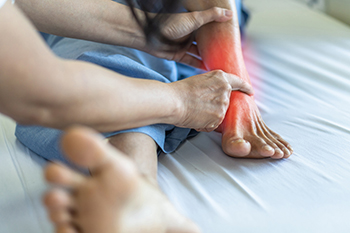 Ankle pain can sometimes be caused by rheumatoid arthritis (RA). This autoimmune disease which attacks healthy tissue can often start in the joints of the feet and ankles. When RA attacks the lining in the ankle joint, it becomes inflamed and damaged, along with ligaments and cartilage surrounding the joint. Over time, this deterioration weakens the bones of the ankle, causing them to rub together. This can cause pain in the ankle (which worsens as the disease progresses), stiffness, inflammation, difficulty standing, tenderness, redness and warmth, lack of balance, and more. People with RA in their ankles may also develop corns and bunions, hammertoes, bursitis, pain in the ball of their foot, a collapsed arch, and the shape of their foot may change. Symptoms outside of the feet include a loss of appetite and weight, low grade fever, fatigue, and weakness in the muscles. Genetics, obesity, and smoking can increase your risk of getting RA. If you are experiencing ankle pain, make an appointment with a podiatrist as soon as possible. Along with a physical examination and review of your medical history, your podiatrist may need blood tests, X-rays, ultrasounds, and MRIs to properly diagnose RA and begin a course of treatment to slow its progression and help manage its symptoms.
Ankle pain can sometimes be caused by rheumatoid arthritis (RA). This autoimmune disease which attacks healthy tissue can often start in the joints of the feet and ankles. When RA attacks the lining in the ankle joint, it becomes inflamed and damaged, along with ligaments and cartilage surrounding the joint. Over time, this deterioration weakens the bones of the ankle, causing them to rub together. This can cause pain in the ankle (which worsens as the disease progresses), stiffness, inflammation, difficulty standing, tenderness, redness and warmth, lack of balance, and more. People with RA in their ankles may also develop corns and bunions, hammertoes, bursitis, pain in the ball of their foot, a collapsed arch, and the shape of their foot may change. Symptoms outside of the feet include a loss of appetite and weight, low grade fever, fatigue, and weakness in the muscles. Genetics, obesity, and smoking can increase your risk of getting RA. If you are experiencing ankle pain, make an appointment with a podiatrist as soon as possible. Along with a physical examination and review of your medical history, your podiatrist may need blood tests, X-rays, ultrasounds, and MRIs to properly diagnose RA and begin a course of treatment to slow its progression and help manage its symptoms.
Because RA affects more than just your joints, including the joints in your feet and ankles, it is important to seek early diagnosis from your podiatrist if you feel like the pain in your feet might be caused by RA. For more information, contact Terri Quebedeaux, DPM of Agave Podiatry . Our doctor will assist you with all of your podiatric concerns.
What Is Rheumatoid Arthritis?
Rheumatoid Arthritis (RA) is an autoimmune disorder in which the body’s own immune system attacks the membranes surrounding the joints. Inflammation of the lining and eventually the destruction of the joint’s cartilage and bone occur, causing severe pain and immobility.
Rheumatoid Arthritis of the Feet
Although RA usually attacks multiple bones and joints throughout the entire body, almost 90 percent of cases result in pain in the foot or ankle area.
Symptoms
- Swelling and pain in the feet
- Stiffness in the feet
- Pain on the ball or sole of feet
- Joint shift and deformation
Diagnosis
Quick diagnosis of RA in the feet is important so that the podiatrist can treat the area effectively. Your doctor will ask you about your medical history, occupation, and lifestyle to determine the origin of the condition. Rheumatoid Factor tests help to determine if someone is affected by the disease.
If you have any questions please feel free to contact our offices located in Seguin, LaVernia, Gonzales, and Lockhart, TX . We offer the newest diagnostic and treatment technologies for all your foot and ankle needs.




